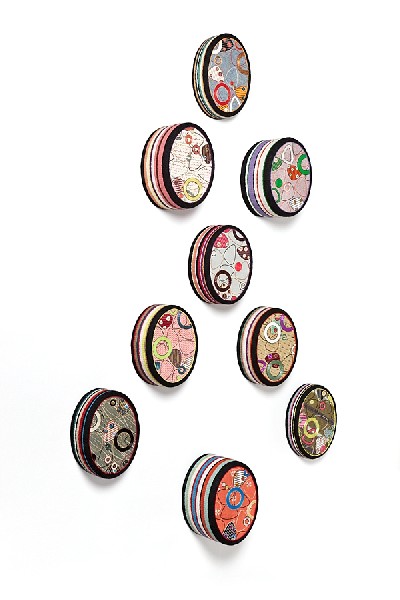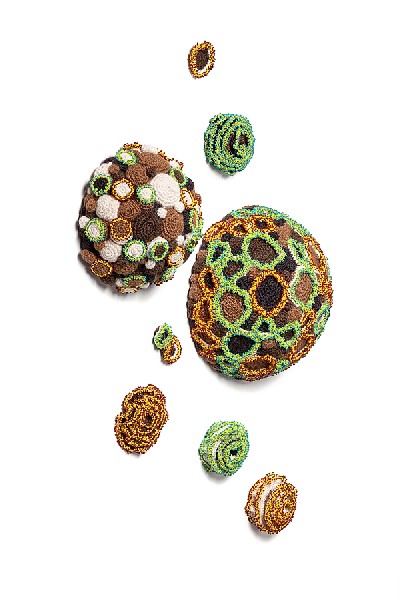Santa Fe Artist Joyce Melander Dayton
The Craft of Turning Nature into Art
By: Edward Rubin - Dec 10, 2012
Edward Rubin You’ve made a lot of interesting, and I might add, major changes in your life. First you moved from Minneapolis to Santa Fe. You also stopped being a representational painter and now work primarily in 3-dimensions using textiles, fabrics, glass beads, wool, and wood veneers. What made you switch gears so radically?
Joyce Melander-Dayton After a while I would paint these objects and I would paint them really, really well, really hyper-realistically, and it seemed almost absurd. I wanted to be that realistic but I found the rendering of the object itself, no matter how true to life, redundant. I realized I was using this as a vehicle for really working with color and different textures. I didn’t want to be known just for my ability to render stuff. I wanted to make a thing itself and not a reproduction of something that already existed.
ER The difference between Minneapolis and Santa Fe is like night and day. I am assuming that this move had a great affect on you.
JMD It did. It changed my way of thinking, seeing, and feeling. If you read Willa Cather’s Death Comes for the Arch Bishop you will understand. The way it is in Minneapolis is you look at the natural world as its periphery. You’re living in the city and the land is somewhere out there. You move to New Mexico or any place like that and you realize that you are surrounded by this gigantic expanse of landscape. The sky is big, the land is big, and it makes your thinking bigger, freer. Just having this around you opens your mind to different possibilities. I don’t think that I could do the work I do in a place that didn’t have big giant horizons and crystal clear air where colors pop. In Santa Fe there is no haze. Everything is crisp.
ER Your work involves crocheting, weaving, embroidering, sewing, beading, felting, and jigsaw cutting, all traditional craft methods, and yet your work has always been a lot more about art than craft.
JMD It isn’t craft. A lot of craft implies some sort of functionality and this is not. I don’t think that there should be a difference between art and craft. I think we’ve forgotten how to use our hands. The tendency is to put down people who use their hands. I am particularly bothered by too much technology getting in the way. I know that people can use technology to make things but the only way they’re using their hands nowadays is using the mouse or typing.
ER Though there is a thru line in all your work, meaning each of your works are immediately recognizable as coming from your hand, yet each work is totally unique. Where do you get your ideas?
JMD It’s all intuitive. As I’m working and this is my big beef with people who primarily use fabricators because ideas are a dime a dozen but if you sit there and spend a bazillion hours working something through ideas do come. I think that working with your hands that much jogs your brain, your subconscious. You’re not just doing repetitive stitching you’re thinking at the same time. I think that it is really necessary for the artist to sit there and do their own fabrication so the next idea will be fermenting while you are doing that.
ER Let’s talk about your wall sculpture Metamorphosis. It looks organic, almost alive, like a wayward colony of spores. How did the various shapes in this work materialize?
JMD I go hiking a lot. I see mushrooms. I see stuff growing on trees. But I never think I am going to make something that looks like this. It just sort of pops into my head and I go, Oh yeah that’s kind of like what I saw on that hike. But then you take it other places. You just don’t reinterpret your hike you take it to someplace new. I am very much influenced by being outside, and I bring the nature back into my studio. This piece does resemble spores that I have seen.
ER Can you tell me about Harvest? This seems to be a new direction for you.
JMD It is. In Harvest, I have all of these Styrofoam balls that I’d knit around. I then throw them into the washer to felt them, which shrinks the wool to fit the ball. Then I add the details. This is my first piece whose elements are not wholly attached to the wall. They actually pop off the wall. I am interested in creating works whose elements are suspended in air, perhaps even hanging from the ceiling. This is a direction that I want to explore.
ER Looking at your work closely, which it demands, is like looking at the inner workings of an ornate clock. Each exquisitely bejeweled work is intricately constructed. How long does it take for you to create a finished work?
JMD That’s the worst worst question on the planet. You don’t want to know that because then you would never do it. (She laughs). Because I work on multiple pieces they all evolve over months to a year. Some of them take a couple years to complete. Theme and Variations took 2 or 3 years to complete. Of course, I am always working on a number of pieces at the same time.
ER When I think about the intricacy of your work and the time it takes for you complete an individual work I cannot help thinking of Penelope who spent 20 years waiting for Ulysses to return home. I am sure that she did a lot of embroidery. Even Madame Defarge, from Tales of Two Cities, spent every waking hour knitting the names of those to be guillotined during the coming French revolution. Tell me about your relationship to your work. It must take a lot of patience.
JMD My relationship to my work is all about process. I love the process. Taking an idea and bringing it alive. It’s all about creating. I have no attachment to finished product itself. For me, it’s all about making it -- the journey so to speak, and of course patience and dedication, both of which have always come naturally to me.
Editor’s Note: Interview was conducted on September 14, 2012 at the Rymer Gallery, Nashville, Tennessee.









